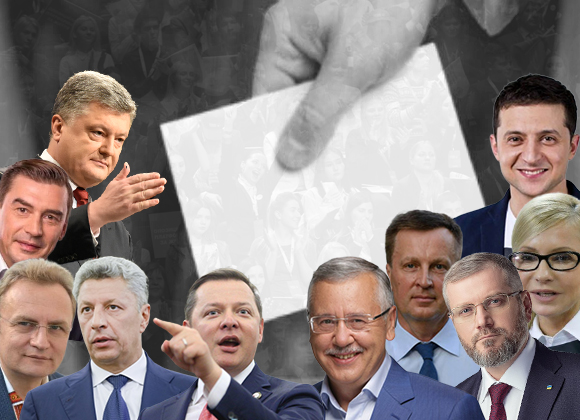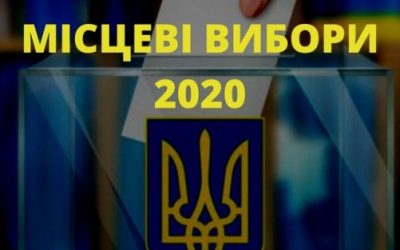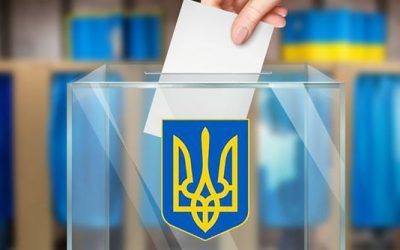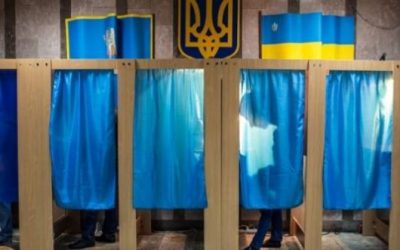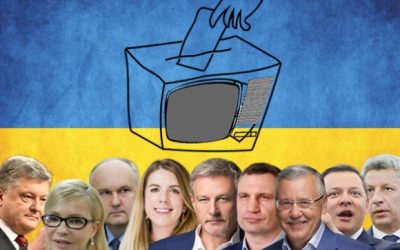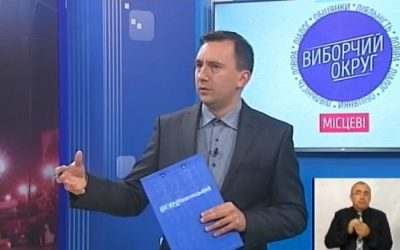The results of the presidential campaign on television. Election Detector
How we fell asleep at the switch in terms of Zelenskyi, what can be done with PR in the news and concealment of ratings, whether there was a noticeable Russian information influence, whether the National Public Broadcasting Company accomplished its mission, and whether the media will rebroadcast videos.
Election Detector No. 12 April 15—21, No. 11 April 8–14 , No. 10 April 1–7, No. 9 March 25–31, No. 8 March 18–24, No. 7 March 11–17, No. 6 March 4–10, No. 5 February 25 — March 3, No. 4 February 18–24 , No. 3 February 11–17, No. 2 February 4 –10, No. 1 January 28 — February 3.
“Election Detector” is a weekly analytical review which timely captures the main topics, trends, manipulations, and changes in the information space, related to the election. Read more detailed analysis in our regular (television news, weekly TV magazines, political talk shows, information channels) monitoring studies. After 12 weeks of the analysis of presidential campaign, we sum up and make a pause until the beginning of August, when the open phase of the parliamentary campaign will begin.
Read this article in Ukrainian
The old media fell asleep at the switch in terms of Zelenskyi. The growing popularity of the idea of choosing the showman Volodymyr Zelenskyi as the president was well documented by means of sociology; his supporters were grouping and were active in social networks, but traditional media behaved like all of this was a joke. The analogy with 2004, made by Otar Dovzhenko, “Detector Media” expert, in the results of the first round, is only partially appropriate. Fifteen years ago, because of the Kuchma-Medvedchuk’s censorship the most popular television channels, radio stations, and newspapers were required to keep silent about the favorite of the population, the opposition candidate Viktor Yushchenko. However, it seems to us, that now journalists and editors themselves did not take Zelenskyi seriously. After all, concealment of information about Zelenskyi by large TV channels before the first round could still be attributed, for example, to the pressure exerted by their owners, which is either the result of an agreement with the current authorities or the result of the fact that they were acting in their own interests, whereas the lack of attention of independent media and investigative journalists to the figure and the phenomenon of Zelenskyi, his team, ties, partners, campaign financing, etc. cannot not be attributed to such a pressure. This was a conscious choice of editorial teams of independent media. The results of February-March show that there were far less mentions of Zelenskyi in the news than mentions of Petro Poroshenko and Yulia Tymoshenko. Only in the second week after the first round, the difference between the number of mentions of candidates who would take part in the second round of the election became less striking, although Poroshenko was still mentioned far more often than Zelenskyi.
Zelenskyi’s marketing strategy, which was focused on other communication channels, is only one, and hardly the main, reason why the top TV channels (with the exception of “1+1”) showed their audience a distorted picture of the election reality. Indeed, the candidate almost did not seek meetings with journalists, did not invite them to press conferences, and did not come to live interviews. That is, he almost did not use the “black” and “gray” commercial opportunities which television channels offered to election participants. But the very willingness of a large part of the society to vote for the TV presenter was a sufficient “coverage opportunity” for television channels to find out what was going on and how real this prospect was. Instead, they were constructing a reality in which Petro Poroshenko and Yulia Tymoshenko were the main contenders for the post of a president, and – depending on the interests of the media owner – Yuriy Boyko, Oleh Lyashko, Oleksandr Vilkul, or Anatoliy Hrytsenko were on their heels. Independent media and investigators were also only focused on Petro Poroshenko and Yulia Tymoshenko.
One of the sad conclusions that has to be repeated after each election campaign is as follows: the top media did not provide complete, unbiased, and critical information about presidential candidates, their background, programs, and intentions. Practically everything the viewers could learn about candidates when watching television was advertising and PR. It is indicative that there was an substantial decrease in the number of mentions of politicians in the news in the period between the first and the second round of elections: attention to their initiatives, achievements, and thoughts immediately ended along with the election budgets.
During the election campaign, we were constantly talking about PR-digests — collections of statements, election promises, and pseudo-news, which included the majority of mentions of candidates in television news and weekly newscasts. There were such digests on “Ukraine”, ICTV, STB, and “Inter”. It is the absence of such a format – PR-digests – which ensured that, according to the monitoring conducted by “Detector Media”, the news on “1+1” was comparatively clean. Despite the fact that “1+1” was the leader in terms of black PR against Petro Poroshenko in non-news formats and was consistently promoting “its” candidates – Zelenskyi, Oleksandr Shevchenko, and Viktor Bondar, – PR-digests as a “legal” form of materials with signs of advertorial (“native advertising”) actually distort the reality to the same extent as concealment or exaggeration of the role of certain candidates, which one could see on “Priamyi”, “1+1”, “Inter”, and “Ukraine”. The fact how often candidates were given the floor in the news was neither related to their rating (the result of Valentyn Nalyvaychenko, who was regularly promoted on “Ukraine” and “Inter”, is significantly worse than the result of Ihor Smeshko, who was practically not mentioned in the news of the central channels), nor to their participation in real political life, existence of real coverage opportunities, or the content of their statements. For example, on March 8, Nalyvaychenko declared his love to the “beloved Ukraine”, whereas at ICTV and “Ukraine” Oleksandr Vilkul was plowing the sands by telling the news about “young people in balaclavas”, who had allegedly attacked his advocates – this is the level of “information” to which news correspondents had to resort in order to ensure compliance with election budgets.
We all understand that PR in the news is a violation of the spirit – if not the letter – of the electoral law. It distorts the real information picture, gives an unfair advantage to certain candidates (it will just suffice to mention dozens of studio interviews of Vilkul and Lyashko on “Ukraine” channel and Boyko’s interviews on “Inter” channel), encourages candidates to incur shadow election expenses, clogs the informational space with meaningless noise, displaces information about truly important events in the news, and corrupts the media. At the same time neither the Central Election Commission nor the National Council on Television and Radio Broadcasting are ready to take responsibility and demand that television channels stop this practice. Moreover, election participants and their staff do not appeal against the behavior of competitors. How to legislatively limit politicians’ ability to be promoted in the news, while not preventing journalists from covering the election process honestly — this is the main challenge for media and electoral watchdogs, and an answer to this question must be given as soon as possible, in order to do this before the start of the parliamentary campaign. Then the change of the rules of the game can become a farewell present of the current convocation of the Verkhovna Rada.
Concealment of the results of sociological surveys, which demonstrated Zelenskyi’s advantage as early as in February, is symptomatic. Pinchuk’s channels, “Ukraine”, Channel 5, and even the public “UA:Pershyi” mostly simply ignored the results of surveys conducted by authoritative sociological institutions: “Democratic Initiatives”, Razumkov Center, Kyiv International Institute of Sociology, and “Rating” agency. These ratings were often replaced by the results of polls conducted by dubious companies, which gave hope to second-third-tier candidates and exaggerated or diminished leaders’ chances. “Inter” channel, which was also using the “regional ratings” technology, that is, reported that Yuriy Boyko is “a leader in a certain region,” referring to both adequate and promoted sociological surveys, was the most outstanding in this regard. “Ukraine” channel changed the tactics before the first round and instead of promoted polls, began to broadcast forecasts of political commentators (in particular, Kost Bondarenko), who highly assessed the chances of Oleh Lyashko and/or Oleksandr Vilkul to take part in the second round of the election.
Even in the last week before the second round, the majority of TV channels ignored adequate ratings, while some, in particular Channel 5, which is owned by Poroshenko, published the obviously fake ratings of the Drahomanov Institute, according to which Petro Poroshenko’s support was twice as much as the real figure, instead of adequate surveys conducted by the “Rating” agency and the Kyiv International Institute of Sociology.
Political talk shows also did not show the true picture. All of them were, in one way or another, used by the owners or political patrons of television channels to promote or discredit certain candidates. Instead of playing the role of an open medium for discussion and expression of election standings, the triad of top political talk shows on Viktor Medvedchuk’s channels (“Pulse” on 112, “Protystoyannya” [Opposition], and “Ukrainian Format” on NewsOne) played the role of a favorable medium for the promotion of the “Opposition Platform – For Life”, exaggeration of some sensitive topics (for example, alleged oppressions of Russian-speaking people in connection with the law on language, which was considered by the Verkhovna Rada), and promotion of pro-Russian propaganda (for example, about the alleged planned falsification of elections by the current authorities). Participants of these programs practically did not change during three months, moving from one studio to another. The logic of a normal television show, which requires dynamics and topicality, cannot explain why the former chairman of the Kyiv Regional State Administration Oleksandr Horhan, the black-mouthed ex-minister Yevhen Chervonenko, and the host and businessman Andriy Palchevskyi were “debating” in the studios of these channels for ten hours a week. It also cannot explain why the same two or three topics, including the language law, were discussed here for months. The only obvious reason is the desire to create a favorable background for the programmatic theses of the “Opposition Platform – For Life” and its “leader” – Viktor Medvedchuk, – which are also favorable to Russia.
“Svoboda Slova” [Freedom of Speech] on ICTV played the role of a medium for self-promotion and hidden campaigning, which was used by various candidates — Petro Poroshenko, Yulia Tymoshenko, Anatoliy Hrytsenko, Oleksandr Vilkul, Ruslan Koshulynskyi, and others. Viewers of ICTV did not see Yuriy Boyko (whom Pinchuk’s channels were consistently ignoring) and Volodymyr Zelenskyi (who was consistently ignoring live broadcasts, having made the only exception for “1+1”). The organizers of the show were carefully preventing any discussions in the studio — both by the format of programs and by inviting guests who were asking questions and commenting on the speeches of the main speakers, and who mostly included their supporters and political commentators loyal to them. Thanks to the “Freedom of Speech” and even more distilled PR-format, which was launched on “Ukraine” in February (“The Main Topic. The Choice”), the word combination “warm bath”, which media critics have been using for a long time when referring to servile interviews, became popular among the population.
“Inter”, which supplemented its weekly show “Podrobytsi tyzhnia” [Details of the Week] with the studio talking format “Podrobytsi vyboru” [Details of the Choice] was the most explicit about the PR of their political patrons. Only politicians from the “Opposition Platform – For Life” were invited to take part in the first part of the broadcast, whereas either persons who are loyal to them, or those who criticize the current authorities, were invited to take part in the second part. “Echo Ukrainy” [Echo of Ukraine], the show by Matviy Hanapolsky on “Pryiamyi” channel, also had nothing in common with the journalistic standards. Most often, it is Petro Poroshenko’s supporters that were invited to take part in this show, but the host himself was the most ardent defender of the president and the most ardent critic of his rivals.
“Pravo na Vladu” [Right to Power] talk show on “1+1” could be called The Club of Those Who Criticize Poroshenko. However, it was here that the most interesting live events took place: Zelenskyi’s first teleconference, presentation of his team, Petro Poroshenko’s invasion into the studio, the signing of a memorandum of fair elections between candidates (television viewers saw some of them nowhere except for the “Right to Power”). It was opposition presidential candidates (with the exception of Yuriy Boyko, who is taboo on “1+1”) that usually met in the studio and criticized the current president in his absence and in the absence of people who could represent his interests. The emotional and obviously biased behavior of the program host Natalia Moseychuk at the end of the election campaign even surpassed Matviy Hanapolsky.
The position of the “Narod Proty” [People Are Against] on ZIK channel was the least obvious of all: in terms of numbers, Poroshenko’s supporters prevailed here, but in the studio there were always politicians and political commentators who were ready to oppose pro-presidential speakers. After the first round, Zelenskyi’s advisers started receiving invitations to take part in this talk show, just as in other political talk shows. However, the most obvious tendency of the talk show in April was a reorientation to parliamentary elections. One week after the vote, the seats in the studio, which candidates and their representatives have just vacated, started to be taken by potential leaders of parliamentary factions. In the meantime, Oleh Lyashko, Serhiy Kaplin, Serhiy Rudyk, and other figures whom the channel have been promoting for years have not disappeared from the news on “Inter” — this channel obviously believes in the power of the old methods of promotion. After a brief break, “Ukraine” restored Lyashko’s PR in the news – we are now waiting for other regulars.
From late January, when Volodymyr Zelenskyi outran Yulia Tymoshenko and took the first place in sociological rankings, until late March, when his superiority was evidenced by the vote, the media did not perform one of their important functions — to help the audience prepare for changes. By concealing the high level of support of Zelenskyi, by diminishing it with the help of fake ratings, or by exaggerating the chances of other candidates, they led to the fact that the election results became a shock for a part of the society.
The media — and primarily television — helped candidates’ teams create a distorted picture of social reality for voters. In particular, by broadcasting two versions at the same time: president and prime minister’s “official” reports on victories and achievements, presented without any verification and additions, and the exaggerated dark picture of poverty, corruption, inefficient public administration, and unsuccessful reforms, which was favorable to opposition candidates (primarily Yulia Tymoshenko and Yuriy Boyko). Petro Poroshenko was using the achievements of decentralization and other reforms, including those in whose implementation he was not directly involved, in his de facto campaign. Volodymyr Zelenskyi did not provide objective criticism of the reforms, but was emphasizing the fact that the authorities are corrupt, while not expressing a clear position on how the reforms would be implemented in the event of his victory in the election. There was an unhealthy situation, where those who spoke impartially about reforms, changes in the state, and successes in the economy were considered to be “porohobots” [those who support Poroshenko], and those who were criticizing the unsuccessful decisions were considered to be supporters of the opposition. This stimulated self-censorship (journalists simply refused to speak on these topics) and deprived the media and the society of the chance to have a meaningful discussion about reforms, their prospects, and effectiveness. At the same time, according to sociologist Volodymyr Paniotto, the media had an influence on the formation of citizens’ false ideas of the situation in the economy, changes in the welfare of the society and in their own welfare. In the situation of the initial low level of trust in the current authorities, the audience was naturally more inclined to believe the version of reality promoted by the opposition.
The direct Russian information influence on the election campaign was not decisive. It was replaced by the promotion of theses which are favorable to the Kremlin through Ukrainian pro-Russian media. In the monitoring of Ukrainian and Russian political talk shows, we have repeatedly noted that there were similar theses promoted both by the Kremlin TV channels, Medvedchuk’s channels, and “Inter”, in particular those about the possible disruption of the elections and about the fact that their result will not be legitimate due to falsifications. These predictions had nothing to do with reality and were fueled by the news about networks of bribes and other technologies whose real scale is likely to remain unknown to the public. However, when the participants of the second round became known, there was quasi-pluralism in Russian talk shows – there were numerous and contradictory assessments of future actions, prospects, and the potential of Poroshenko and Zelenskyi, as well as the consequences of their victory for Russia. Poroshenko remained the main target for criticism, even though hosts or commentators sometimes made remarks about the fact that the old well-known evil is probably better than the new and unknown one. Commentators were analyzing Zelenskyi’s statements scrupulously, looking for signs that the future president (and no one doubted his victory in the last weeks) is also a Banderite and the enemy of the Kremlin. After his victory, the Kremlin talk shows said that May 9 will be the final test for Zelenskyi — whether “he will bring the holiday back” (which, as you already know, was not even canceled) and what he will say on the occasion of the anniversary of the Soviet version of the Day of Victory over Nazism. Even the fact that Zelenskyi changed the name of his Facebook page became the sign of servility for Russians.
Ukrainian “experts”, who were invited to Russian talk shows, were playing an important role in creating a picture of political chaos and a forthcoming apocalypse in Ukraine. In the last weeks, a former Ukrainian journalist, Yanina Sokolovska, who now works in the Russian newspaper “Kommersant”, was convincingly playing the role of Poroshenko’s defender, saying that he “left the post with honor,” and Zelenskyi’s victory is “the victory of television over reality.” She also argued that Zelenskyi would be an obedient instrument in the hands of Donald Trump. Other former Ukrainians were either in favor of, or against, Poroshenko, depending on a situation, without taking care of the consistency of their position. The latest news, namely Kolomoisky’s appearance on NTV and the announcement of the “new” “Magic” program, which had been filmed eight years ago, and in which Zelenskyi was a host, is indicative of the fact that the game of the Russian media with the newly-elected president of Ukraine is just beginning. The rhetoric will probably change before the parliamentary elections. After all, in all the insane interpretations, conspiracy theories, accusations, and curses in the discussions of Ukrainian politics in Russia only two surnames were always mentioned in the positive context: Medvedchuk and Boyko.
Fakes and serious manipulations were not the main trend of this election on television. As for manipulations, we can speak about the coverage of bookmakers’ stakes instead of the results of sociological surveys, the diminution of Volodymyr Zelenskyi’s assets, and exaggeration of Petro Poroshenko’s “enrichment” (the figure “82 times” went the rounds, which referred to income, rather than president’s wealth), accusations against Poroshenko of using Putin’s election slogans, fake news about the death of Tymoshenko’s tigress, “Privat-challenge” of presidential candidates with the accusations against Kolomoiskyi of the plunder of the bank, Boyko and Vilkul’s mutual accusations of servicing the authorities and fake opposition, justification for the contraband in “Ukroboronprom”, discussion of Poroshenko’s fictitious plans to “cancel March 8”, a photo in which Poroshenko is “fleeing from voters”, forecasts of the results of elections from psychics and numerologists, a false Russian trail in a video from the “Olimpiyskiy” stadium, a fictitious list of candidates for key positions from the alleged staff of Zelenskyi, intimidation of the audience by a possible mortar shelling of the stadium, exaggeration of a scandal involving the use of the word “rebels” by both presidential candidates, and – probably the funniest one – accusations against Olena Zelenska of urging the authorities to provide information on location of Ukrainian servicemen to the militants. Most of these manipulations were fleeting and were forgotten even faster than they were refuted. As for the more coordinated campaigns of black PR the theses about Zelenskyi being a drug addict and various speculations on the results of the bihus.info investigation into corruption in the defense sector, as well as accusations against Poroshenko of being involved in assassinated murders, including the alleged murder of his own brother, were the most noticeable of all.
Did public television accomplish its mission — to be an independent source of unbiased information about candidates, which helps make an informed choice? Yes and no. On the one hand, “Zvorotnyi Vidlik” [The Countdown] talk show and “The Great Political Evening” on April 19, and, in particular, the debate before the second round, which Volodymyr Zelenskyi did not want to take part in, but which Petro Poroshenko attended instead, are an undoubted victory. Apt questions, strict regulations, live fact checking, “plan B” in case of the absence of speakers — all these are signs of television, which Ukraine had not had before. On the other hand, the National Public Broadcasting Company failed the coverage of the election in the news. The fact that they were ignoring political topics and even the very references to presidential candidates, on the one hand, provided “UA:Pershyi” with the status of a channel with “clean” news without PR and native advertising, but on the other hand, it deprived viewers of the chance to learn something about the candidates, which they would never see on television channels which are owned by oligarchs. They only managed to make dossiers on the top candidates in the last week before the vote. Only Michael Shchur’s program spoke about the existence of Volodymyr Zelenskyi. “Tema Dnia” [The Topic of the Day], whose running time was increased by two times after the first round of the election, became a reservation for political topics on the air of the main public broadcasting channel. However, as the “Detector Media” has already written more than once”, even two political interviews with the inclusion of experts per day are not a substitute for the coverage of political events in the news. “Detector Media” will soon publish the results of the monitoring of the branches of the National Public Broadcasting Company, but even now it can be stated that some of them were bolder and more adequate when covering election topics which were topical in their regions.
When covering scandalous election stories, from the investigation into corruption in “Ukroboronprom” to Volodymyr Zelenskyi’s evasion of military service, the media were passive and showed that they are ready to work in accordance with the scenarios that are favorable to their political patrons. As for the majority of channels (except for “1+1”), it was advantageous for them not to bug Poroshenko and not to mention Zelenskyi, scandalous topics were not fully covered, TV channels did not conduct their own investigations and did not check statements made by people involved in scandals.
There was one information wave after another: C14 rallies with a reminder of the murder of Kateryna Handziuk, removal of Ulyana Suprun from office on the initiative of the Radical Party of Oleh Lyashko, accusations against Tymoshenko and Poroshenko regarding bribery of voters and preparation of falsifications, attempts of Poroshenko’s staff to interpret the “Servant of the People” as campaigning, investigation of “Nashi Hroshi” [Our Money] into Oleh Hladkovskyi and Ihor Hladkovskyi, cancellation of the article of the Criminal Code of Ukraine on unlawful enrichment, investigation into illegal sources of money for the Yulia Tymoshenko’s election fund, the attempt to bribe Yuriy Tymoshenko, the rallies of “National brigades”, Boyko and Medvedchuk’s trip to Moscow, dismissal of Gordeyev, Ryshchuk, Stepanov, Semochko, and other scandalous officials, extradition of Dmytro Kryuchkov, the court ruling on the illegal nationalization of “Privatbank”, etc. Rarely did television news return to resonant events after the information wave subsided; they did not check the facts and did not follow the course of the investigation, unless law enforcement authorities drew their attention to a particular topic. It can be assumed that television channels understood the election function of compromising material, but consciously agreed to be its disseminators. We’re having a hard time believing that news programs will watch scrupulously the investigation into the case of “Ukroboronprom”, the fate of those accused of bribing Yuriy Tymoshenko, or the consequences for those who allegedly formed “networks” for the bribery of voters.
Media and the president: the format of relations will change. During all five years of his incumbency, except for the last three weeks, when Petro Poroshenko was desperately breaking into every broadcast and was ready to debate with anyone, he was not a president who was working with the media. He rarely held press conferences, gave interviews mostly to loyal journalists, where questions were agreed in advance, did not take part in debates and political talk shows, and was practically not criticized in the media which are owned by oligarchs — with the exception of “1+1”, which, however, maintained intense neutrality and did not criticize Poroshenko until 2018. The non-aggression pact between the oligarchic media groups and the president, which excluded personal criticism and provided for the coverage in the format of “official speeches” and soft PR, lasted for at least three years. Such an informational policy was protecting Poroshenko from uncomfortable communication, but prevented neither formation of significant disapproval rating, including because of the large-scale criticism of the authorities “in general” on many channels, nor the defeat in the election, where the president clearly considered Yulia Tymoshenko to be his main rival until the last months. His decision not to conduct a classic campaign, but to position himself as a “president, rather than a candidate,” reflected in television news and on billboards (“There are many candidates, but there is one president”) was wrong and contradicted democratic practices. The use of Channel 5 and Medvedchuk’s “112” channel for PR and the use of “Priamyi” for large-scale black PR and discreditation of opponents deprived Poroshenko of moral superiority and cast a shadow on him, without producing any positive results.
Even before being elected, the newly elected president, Volodymyr Zelenskyi, demonstrated that he did not need traditional forms of PR in television news and talk shows. He replaced part of his campaign with entertainment content on television and concert performances of “Evening Quarter” and the “League of Laughter”, while another part of the campaign took place outside the traditional media — in social networks and on the Internet in general. “The Collective Zelenskyi“, who served as a substitute for the newly elected president himself in the media in the first week after the election, is a dangerous precedent. He shows the reluctance and the lack of a need for the head of the state to be accountable to the media as the controllers of the authorities, which represent the society, and to communicate with them.
Instead, there is a populist idea of ”direct communication with the people” with the help of social networks, where a considerable part – but still just a part – of citizens play the role of the people. According to the results of the survey conducted by “Detector Media”, television is the main source of news for three quarters of Ukrainians. Social networks are the main source of news for a quarter of citizens. There is no function of a qualitative filter and fact checking in direct communication, which Zelenskyi’s team contrasts with the “old” indirect one, and the politician allows himself to only speak about things that are beneficial to him. This tendency was clearly evidenced by Zelenskyi’s statement about the “delay” in the announcement of election results, which he made on the day when Putin’s decision to simplify the procedure for issuing Russian passports to residents of the occupied territories of Donetsk and Lugansk regions was the main news. Instead of the newly elected president, his impersonal “team” commented on this event, whereas he himself reacted to this only two days later.
One can get an idea of how the media will work with the messages of the new president by looking at the coverage of the “debate battle”, which took place in the period between the first and second round, in the news on television. The news was focused on the form of a spectacular exchange of televised speeches, trips to the stadium, undergoing medical tests, and other elements of meaningless distance communication between the candidates. At the same time, we would like to remind you that a significant part of viewers did not see candidate Zelenskyi in the news until March 31, because the channels of three oligarchic television groups were consistently ignoring him. Instead of finding out and explaining who is this person who is a candidate for the post of the head of state, news programs mythologized his figure even more. After all, the debate, which was the top topic in the last three weeks, did not change anything, but consumed time and attention that could be used, for example, to find out the reasons and circumstances of Serhiy Semochko’s dismissal.
The most dangerous thing that can happen to television and other traditional media is that they will accept the role of rebroadcasters of president’s messages, which Zelenskyi’s team has given them. So far, this is exactly what they have been doing by tracking and retelling the signals given by Zelenskyi himself and his ephemeral “team”, whose status is now completely unclear. There is once again an exception of “1+1”, which is now trying to “explain” the personality, actions, and plans of the newly elected president to the society even more actively than before. In particular, to also play the role of a lightning rod of negative news, for example, those about the greetings from Yanukovych and Ramzan Kadyrov.
The innovative campaign with in-depth targeting of groups of voters and sending messages which are specifically designed for each group, the use of various communication channels, consolidation of electoral groups prejudiced against Poroshenko, and other circumstances allowed Zelenskyi to become president without answering at least one inconvenient question. He remains a mystery, his intentions and statements remain ambiguous and controversial, and people who speak on his behalf do not have any status, but de-facto already have power and influence on the society. Despite the dependence, bias, self-censorship, and other untreated or undertreated diseases, the media are the only public institution that can guarantee accountability of the head of state to citizens. Therefore, the main task for the media in the coming months is to ask the new president questions and obtain answers. After all, we have not received meaningful answers to the majority of important questions that were asked earlier:
